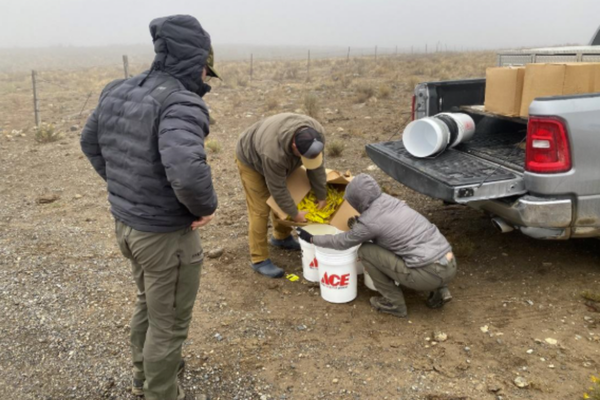Conservation Commons: Deer Collaring 101
Since 2015, the Idaho Department of Fish and Game (IDFG) has collared 400 mule deer per year, more than any other state in the west, as part of an ongoing project focused on gaining a more intricate understanding of ungulate movement and lifecycles. In January, IWF’s Brian Brooks and Becca Aceto participated in net drives with the goal of collaring mule deer fawns as part of this larger project.
A volunteer finishes setting up the net before the helicopter arrives.
The day’s events began in the morning hours among the sagebrush hills of southwestern Idaho. A group of IDFG biologists, staff and volunteers gathered supplies and set up the long net, utilized to capture deer safely and effectively, giving biologists the opportunity to gather data, collar and ear tag fawns and quickly release them. The phrase “hurry up and wait” came to mind as the group waited for word from the helicopter pilot stating they were on their way. With the sun high in the sky, voices finally came over the radio inciting a flurry of activity, each person finding a spot among the sagebrush and bitterbrush to wait for the first round of animals. For several hours the helicopter scanned the hillsides, pushing mule deer toward the nets, as if a well-trained border collie behind a herd of sheep. When all was said and done at the end of the day, we had collared 12 mule deer fawns, giving special solar-powered ear tags to the buck fawns (more on those later). People dusted dirt and debris off their clothes and headed back to the trucks while mule deer fawns in the surrounding hills ended the day as newly collared members of the herd.
The Project
Mule deer (Odocoileus hemionus) are the most common big game species in Idaho. They thrive across a range of ecosystems, but especially the vast sagebrush steppe which covers much of the southern half of the state. Mule deer migrate twice each year – from their winter to summer range in the spring, then again in the fall from summer to winter range. Understanding the lifecycles of these animals is key to ensuring their success as Idaho and the west continue to grow.
A buck fawn is released with a new collar and solar-powered ear tag.
In early January, when deer are concentrated on their winter ranges and while the animals are still in a body condition indicative of their summer range, IDFG employs a net drive to capture deer. After captured, animal weight, chest girth and hind leg length measurements are taken, giving an idea of the animal’s health going into winter. Radio collars are placed on fawns – doe fawns receive permanent collars that adjust with the animal’s growth over time while buck fawns receive temporary collars due to the swelling of the neck during rut. These collars give biologists valuable information such as migration routes, location of fawning and calving areas, important winter and summer range and whether animals are loyal to certain areas during winter or summer. Buck fawns also receive solar-powered ear tags so that biologists can continue to receive data once their temporary collars fall off. New technology, these ear tags aren’t being used anywhere else in North America and they come to IDFG all the way from Scotland.
Each day, biologists receive two locations via satellite from the mule deer GPS collars and receive a separate email if the collar has not moved for 8 hours, typically indicating an animal mortality. IDFG can then investigate the cause of death, gaining important information on predation, malnutrition, disease, vehicle collisions and other causes.
As an ongoing project, data from collars helps to guide several population metrics used by IDFG to manage mule deer, including:
What percentage of collared animals are recruited into the adult age class?
If the deer didn’t survive, why did they die?
What percentage of collared mule deer does survive each year?
So how do hunters play a role in all of this?
Alongside information gathered under this project, public opinion and hunter harvest data are also taken into consideration when determining hunting seasons and tags for the following year. Hunters who harvest deer with ear tags also aid in research when they fill out their harvest report, giving biologists the opportunity to see where that deer roamed since the time of tagging, as well as an idea of the age of the harvested animal.
This work done by the Idaho Department of Fish and Game will be essential moving forward as Idaho’s wildlife and humans adapt to coexist in a growing and changing state.
Special thanks to Katie Oelrich and the rest of the IDFG staff for inviting IWF to these events, and for their dedication to Idaho’s wildlife and habitat.






